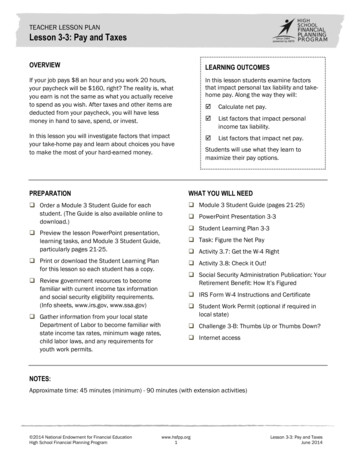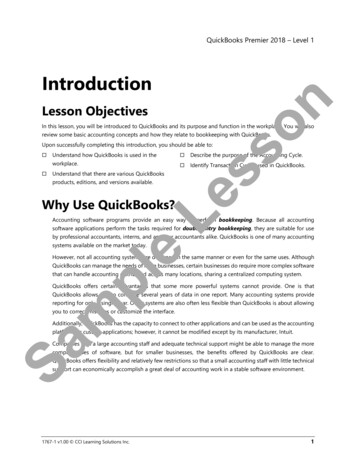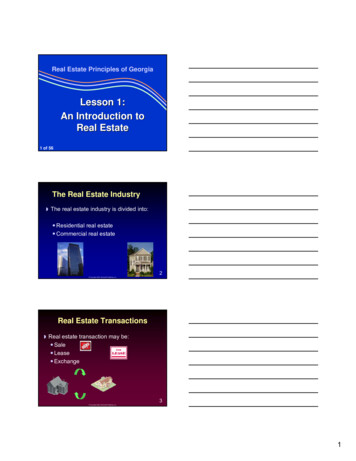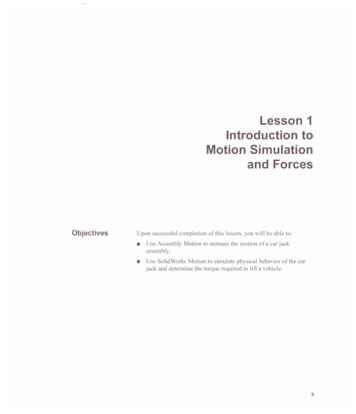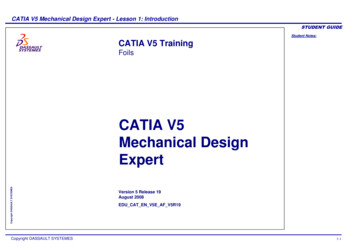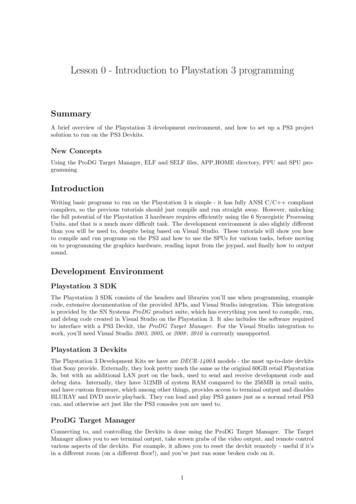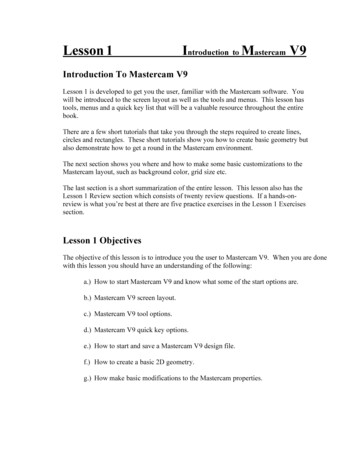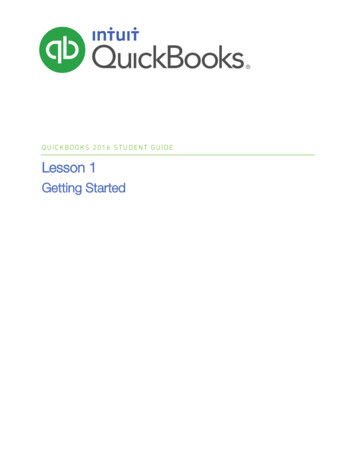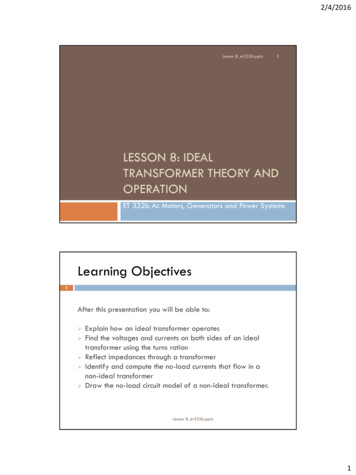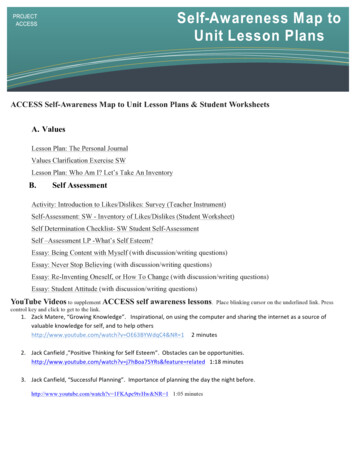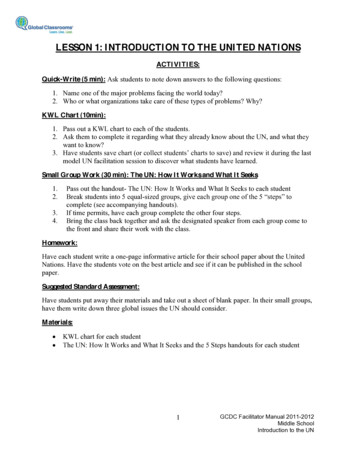
Transcription
LESSON 1: I NTRODUCTI ON TO THE UNI TED NATI ONSACTI VI TI ES:Quick-Write (5 min): Ask students to note down answers to the following questions:1. Name one of the major problems facing the world today?2. Who or what organizations take care of these types of problems? Why?KWL Chart (10min):1. Pass out a KWL chart to each of the students.2. Ask them to complete it regarding what they already know about the UN, and what theywant to know?3. DYH VWXGHQWV VDYH FKDUW RU FROOHFW VWXGHQWV¶ FKDUWV WR VDYH DQG UHYLHZ LW GXUing the lastmodel UN facilitation session to discover what students have learned.Small Group Work (30 min): The UN: How I t Works and What I t Seeks1.2.3.4.Pass out the handout- The UN: How It Works and What It Seeks to each studentBreak students into 5 equal-si]HG JURXSV JLYH HDFK JURXS RQH RI WKH ³VWHSV WR complete (see accompanying handouts).If time permits, have each group complete the other four steps.Bring the class back together and ask the designated speaker from each group come tothe front and share their work with the class.Homework:Have each student write a one-page informative article for their school paper about the UnitedNations. Have the students vote on the best article and see if it can be published in the schoolpaper.Suggested Standard Assessment:Have students put away their materials and take out a sheet of blank paper. In their small groups,have them write down three global issues the UN should consider.M aterials:KWL chart for each studentThe UN: How It Works and What It Seeks and the 5 Steps handouts for each student1GCDC Facilitator Manual 2011-2012Middle SchoolIntroduction to the UN
Common Core State Standards: English Language Arts and DCPS Grade 6 Standards: Social StudiesEnglish Language Arts:6. CC.6.SL.1.b Comprehension and Collaboration: Follow rules for collegial discussions, setspecific goals and deadlines, and define individual roles as needed.Social Studies:6. 3.10: Students identify international organizations of global power and influence and formcommittees to report on the influence and limits to influence each one.Concepts:Reasons for the establishment of the United NationsMain ideas of the Universal Declaration of Human Rights and their impact on the worldJudgments about ideas and evidence for those judgments.Skills:Describe, Summarize, Formulate, SupportSuggested Big I deas:The United Nations was established to promote global peace and security after WWIIThe work of the UN is incredibly important to the global community and impacts ourdaily livesSuggested Essential Questions:What is the UN?How does the UN function?Suggested Engaging Scenario:Students role-play as journalists researching and writing an article on the UN for theirschool or community newspaper.2GCDC Facilitator Manual 2011-2012Middle SchoolIntroduction to the UN
Proficiency CriteriaPerformanceTaskQuick WriteThinking SkillsKnowledgeKWL ChartKnowledgeSmall s, EvaluationPerformance Task Assessment(Proficient Criteria)Usually participates in the class discussions &activities.Usually participates in the class discussions &activities.Usually participates in the class discussions &activities.Generally well-written and well organized. Minorerrors in spelling, capitalization, punctuation,grammar, usage, and sentence structure do not disruptthe fluency of the composition.Words, phrases, and sentence structure are generallyappropriate and contribute to the communication ofideas.3GCDC Facilitator Manual 2011-2012Middle SchoolIntroduction to the UN
KWL ChartName DateComplete the first two columns now with what you know about the UN and what youwould like to know about the UN. Keep the worksheet to complete the last column(What I learned) during the last model UN session.Topic UNITED NATIONS (UN)What I KnowWhat I Want to Know What I Learnedcopyright Houghton Mifflin Company. All Rights Reserved.4GCDC Facilitator Manual 2011-2012Middle SchoolIntroduction to the UN
5GCDC Facilitator Manual 2011-2012Middle SchoolIntroduction to the UN
STEP 1:CREATING ABETTER llab world map.gif6GCDC Facilitator Manual 2011-2012Middle SchoolIntroduction to the UN
Step 1: Creating a Better WorldTask 1: As a group, read the following. Ask questions if you do not understand.The goal of the United Nations is to create a better world by eliminating the problems that have affected humanityfor centuries.A goal is a desired outcome. A goal is something that a person or a group of people want to reach, and the stepsthey need to take to get there.Task 2: ,GHQWLI\ D VSHDNHU ZLWKLQ \RXU JURXS ZKR ZLOO UHDG WKLV DQG \RXU JURXS¶V ZRUN IURP Task 3 to the class.Task 3: Write 3 different problems or issues that affect the world today, in the lines next to numbers 1, 2 and 3.,I WKLV SUREOHP RU LVVXH DIIHFWV WKH 8QLWHG 6WDWHV ZULWH ³\HV RU ³QR LQ WKH FRUUHFW FROXPQ &RPH XS ZLWK DQRWKHU FRXQWU\ WKDW WKLV SUREOHP DIIHFWV DQG ZULWH WKH QDPH RI WKDW FRXQWU\ LQ WKH FROXPQ WKDW VD\V ³ IIHFWV WKLV FRXQWU\ 1.2.3.Affects theAffects thisUnited States?country:(yes or no)(name of country this affects)(yes or no)(name of country this affects)(yes or no)(name of country this affects)Task 4: Find ALL RI WKH FRXQWULHV WKDW \RX OLVWHG LQ WKH WKLUG FROXPQ XQGHU ³ IIHFWV WKLV FRXQWU\ RQ WKH ZRUOG PDS that you will find on the other side of this piece of paper.7GCDC Facilitator Manual 2011-2012Middle SchoolIntroduction to the UN
STEP 2: PROBLEMOR ional/images/collab world map.gif8GCDC Facilitator Manual 2011-2012Middle SchoolIntroduction to the UN
Step 2: Problem or Issue Affecting PeopleTask 1: As a group, read the following. Ask questions if you do not understand.When a country that is a member of the United Nations has an issue that they feel cannot be solved by theircountry alone, they bring this issue to the United Nations to request assistance. Issues or problems may fall intomany categories. Some examples are listed Human RightsTask 2: ,GHQWLI\ D VSHDNHU ZLWKLQ \RXU JURXS ZKR ZLOO UHDG WKLV DQG \RXU JURXS¶V ZRUN IURP Task 3 to the class.Task 3: As a group, fill in the blanks below using the phrases in a through e, from Task 1 above.1. A disease called Tuberculosis has become a very big problem in Southeast Asia. This is a problemrelated to .2. Some groups say that in Venezuela, the government is trying to make people be quiet if they do notagree with the Venezuelan government. This would be an issue relating to .3. In Afghanistan, women and girls are often not in school. This is considered a(n)issue.4. A huge amount of oil spilled in the Gulf of Mexico in 2010. This would be described as an issue of the.5. Recently, the United Kingdom (England) and France have had difficulties with terrorist threats. Thiswould be a problem with .Task 4: Find the country or the area from the fill-in-the-blank questions above (the underlined words) on the worldmap that is on the other side of this piece of paper, to show where this takes place.9GCDC Facilitator Manual 2011-2012Middle SchoolIntroduction to the UN
STEP 3: l/images/collab world map.gif10GCDC Facilitator Manual 2011-2012Middle SchoolIntroduction to the UN
Step 3: The United NationsTask 1: As a group, read the following. Ask questions if you do not understand.The United Nations is organized into different committees or groups of people that come together to solve a set ofproblems or issues. All represented countries on the committee discuss the problem or issue according to theirperspective. Some of the United Nations committees are:a.b.c.d.e.8QLWHG 1DWLRQV &KLOGUHQ¶V )XQG (UNICEF)United Nations Environment Program (UNEP)Economic and Social Council (ECOSOC)United Nations AIDS Programme (UNAIDS)United Nations Human Rights Council (UNHRC)Task 2: ,GHQWLI\ D VSHDNHU ZLWKLQ \RXU JURXS ZKR ZLOO UHDG WKLV DQG \RXU JURXS¶V ZRUN IURP Task 3 to the class.Task 3: Below are 5 topics that the United Nations may be faced with. Match the issue with the committee thatwould discuss it, from Task 1 E\ ZULWLQJ WKH FRPPLWWHH¶V QDPe in the blank space provided.1. Many people are dying from AIDS in Africa2. Raising water levels due to higher temperatures and a change in climatein the Pacific Islands3. The education of women and girls in Yemen4. The situation in Darfur, Sudan, where there is a civil war (a war inside the countU\¶V borders) that kills many innocent people5. When orphanages need clothing for children in North AmericaTask 4: Find the country or the geographic region (the underlined words from numbers 1 through 5) on the worldmap found on the other side of this piece of paper, to show where this is an issue.11GCDC Facilitator Manual 2011-2012Middle SchoolIntroduction to the UN
STEP 4:COMPROMISETHROUGHNEGOTIATION(PLAYING BYTHE RULES ATTHE UNITEDNATIONS)12GCDC Facilitator Manual 2011-2012Middle SchoolIntroduction to the UN
Step 4: Compromise through Negotiation: Playing by the Rules at the UNTask 1: As a group, read the following. Ask questions if you do not understand.Ideas are discussed by the member states of the United Nations during caucuses (or meetings) and formalsessions. After some proposals (or ideas) have been suggested, the ones with the most votes are selected inorder to get widespread support.Each session follows the same order:1. Roll call: This is like taking attendance.2. Setting the agenda: It is decided what topic will be discussed.3. Debate: Each country discusses how they feel about the topic, and how the topic affects their owncountry.4. Close of debate: When everyone is finished sharing their point of view, someone suggests that thesession move on to voting.5. Voting procedures: Each country votes on what plan of action they want the United Nations and the otherpeople involved (countries, governments, etc) to take.Task 2: Identify a speaker within your group who will read the box from Task 1 DQG \RXU JURXS¶V ZRUN IURP Task3 to the class.Task 3: Create definitions in your own words for the session order from Task 1, and write them down to sharewith the class.1. Roll call:2. Setting the agenda:3. Debate:4. Close of debate:5. Voting procedures:13GCDC Facilitator Manual 2011-2012Middle SchoolIntroduction to the UN
STEP 5:RESOLUTIONS(ACTIONPLANNING)14GCDC Facilitator Manual 2011-2012Middle SchoolIntroduction to the UN
Step 5: Resolutions: Action PlanningTask 1: As a group, read the following. Ask questions if you do not understand.When a decision has been made as to how the United Nations will deal with a situation (for example, global warming), an action plan (also known as aresolution) is written about the steps that the United Nations and the involved countries will take. The resolution is supported by the majority of the peoplethere.Task 2: Identify a speaker within your group who will read this, and explain how your group came to the conclusion from Task 3, to the class.Task 3:1. Ask the question to your group: Should we wear school uniforms?2. Take a vote.3. :KHQ \RX FRPH WR D PDMRULW\ PRUH SHRSOH VD\ ³\HV RU ³QR ZULWH D YHU\ VLPSOH UHVROXWLRQ E\ ILOOLQJ LQ WKH EODQNV EHORZOur group believes that that, µ\HV¶ RU µQR¶ , all students should OHDYH EODQN RU ZULWH µQRW¶ wear uniforms to school. The new rule will bestenforced starting on the 1 of , (next month, this year).This deFLVLRQ ZDV PDGH EHFDXVH « (give 2 reasons for why or why not students should be wearing school uniforms to school, to support your decision)1. and2.Task 4: Now use the same format to write a resolution about one issue your group members wrote down during the quick write or class discussion.15GCDC Model UN Lesson Plans for 2010-2011Middle SchoolLesson 1: The United Nations Part I
GCDC Middle School Curriculum SupplementLesson 1: The United Nations Part IThe United Nations: How It Works and What It Seeks!Teacher Guidance Page and Answer KeyMaps would be ideal for this activity, especially for the groups in Steps 1, 2 and 3. If they are not available, or you do nothave enough, there are smaller maps printed out on the worksheets for Steps 1, 2 and 3.Many of the activities and content in this lesson are courtesy of Global Classrooms Los Angeles and will informationobtained from http:www.un.org/aboutun/16GCDC Model UN Lesson Plans for 2010-2011Middle SchoolLesson 1: The United Nations Part I
Step 1: Creating a Better WorldTask 3: Write 3 different problems or issues that are problems within the world today, in the lines next to numbers 1, 2 and 3. If this problem orLVVXH DIIHFWV WKH 8QLWHG 6WDWHV ZULWH ³\HV RU ³QR LQ WKH FRUUHFW FROXPQ &RPH XS ZLWK DQRWKHU FRXQWU\ WKDW WKLV SUREOHP Dffects, and write thename of that country in the column WKDW VD\V ³ IIHFWV WKLV FRXQWU\ 1. Global Warming2. Lack of fresh water3. DrugsAffects theAffects thisUnited States?country:yesMexico(yes or no)(name of country this affects)yesAustralia(yes or no)(name of country this affects)yesColombia(yes or no)(name of country this affects)Teachers: Students answers may vary greatly. The ones listed here are simply suggestions in case your students are having difficulties comingup with ideas. Make sure to point out that almost every issue affects the United States in some way.In Task 4, students should find these countries on the map. Make sure that they find at least the area (sometimes the map may be too small forthe country that the students have decided upon) correctly. When finished, ask the class if they can identify any other countries or areas of theworld that have these issues.17GCDC Mod
The United Nations is organized into different committees or groups of people that come together to solve a set of problems or issues. All represented countries on the committee discuss the problem or issue according to their perspective. Some of the United Nations committees are: a. 8QLWHG 1DWLRQV &KLOGUHQ¶V )XQG (UNICEF) b. United Nations Environment Program (UNEP) c. Economic and File Size: 577KBPage Count: 19People also search forteaching about the united nationswhat funds the UNmodel u.n. activities community collegemodel un fundingunited nations activity for kidsQUICK CROSSWORD Quiz ON THE UN!


